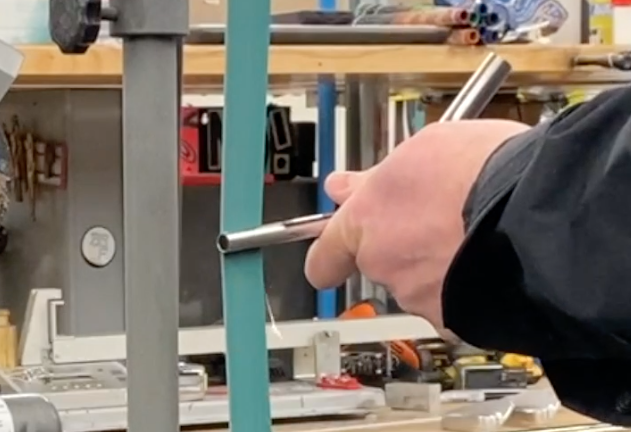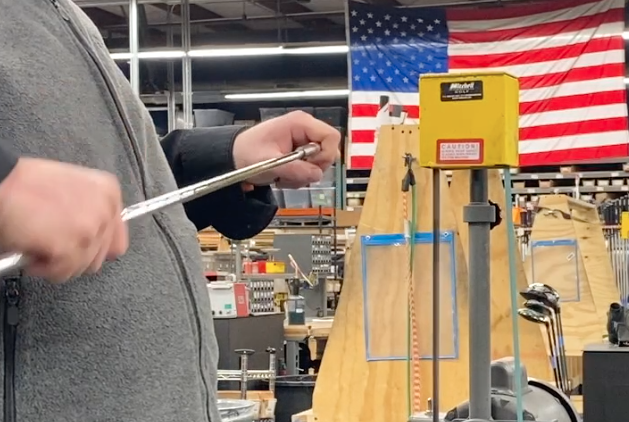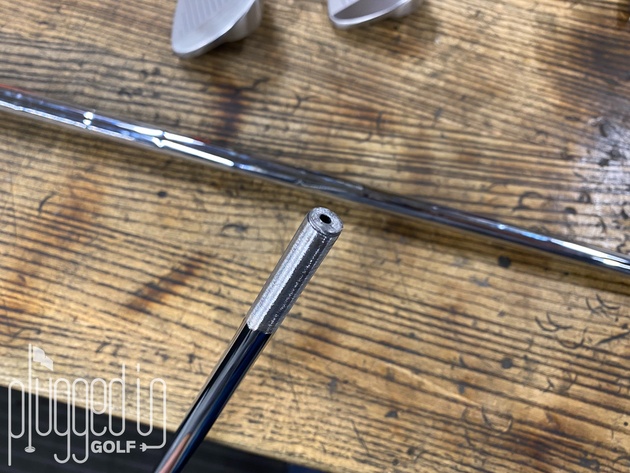Removing the Mystery
Most operations in club building are fairly straightforward. It’s obvious to anyone what it means to cut a shaft. Prepping a shaft, however, can be a little mysterious. Why is it necessary? How is it done? When do you know when you’ve gone far enough…or too far?
We’ll answer all those questions and more in this step by step explanation of how to prep a golf shaft.
What Is Prepping a Shaft?
Prepping a shaft means getting it ready to be installed (glued into) a club head. It’s the process of removing the finish or paint in the tip area so that the epoxy has something it can create a strong bond with. Part of this process is also getting the shaft to fit into the hosel at full depth.
The Tools You Need
Sandpaper
The Tools You Want
1″ Belt Sander
The Process
Step 1: Check the fit. Put the shaft into the hosel dry. If the shaft slides in easily, you’ll want to be a bit more gentle in your prep. If the shaft barely fits or doesn’t fit at all, you’ll need to remove more material.
Step 2: Mark the shaft. Use a pencil or marker to indicate how much of the shaft will go into the hosel. You don’t want to prep the shaft beyond the insertion depth unless the club has a ferrule. In that case, a little extra prep is desirable to ensure a good bond with the ferrule.
Step 3: Prep the shaft. Using either sandpaper in your hand or a belt sander, start to remove the finish/paint from the shaft. With a steel shaft, it’s nearly impossible to go too far. With graphite, it’s very easy to go too far. You know that a shaft is well-prepped when the chrome or paint has been removed from the shaft (see above).
Step 4: Check the fit. Ideally, the shaft should insert to full depth with a tight fit. If you can’t get the shaft full inserted, carefully remove a little more material.
Common Mistakes
Nick noted two common mistakes that amateur club builders make. First is under or over prepping the shaft. If you don’t prep enough, you won’t get a strong bond with the club head. Prep too much and you’ll have a loose fit in the hosel. Either way, the result can be a club that doesn’t stay together.
The other common mistake is not prepping the shaft enough to get to the bottom of the hosel. Be careful with Step 2. You can double check the hosel depth with a screw driver and compare that how much of the shaft you’ve prepped and inserted.
Pro Tips
Prepping a shaft well is all about touch. The best way to develop that is through practice. Get your hands on some scrap shafts, steel and graphite, and practice your technique. This is especially important if you’re new and planning to use a belt sander.
Watch the Video HERE
The Full Club Building 101
How to Measure & Adjust Swing Weight
He founded Plugged In Golf in 2013 with the goal of helping all golfers play better and enjoy the game more.
Matt lives in the northwest suburbs of Chicago with his wife and two daughters.
- Performance Golf Click Stick Training Aid Review - October 18, 2024
- Callaway Opus Platinum Wedge Review - October 17, 2024
- When to Take a Break from Golf - October 15, 2024



















8 Comments
You should never use a belt sander or sand paper on a graphic shaft.
Please use a knife and only remove the paint.
Joe,
Respectfully, I’ll take my club building advice from the guy who founded the #1 custom club builder in the country (world?).
-Matt
The belt sander is fine, but I wouldn’t use even a fine grit sandpaper belt on a graphite shaft. Too easy to cut the fibers. You can get a Norax belt from Golfworks (they do not recommend using sandpaper either).
Regarding prepping a graphite shaft, I’ve always been taught the same as Joe Lavery and Kevin C, who posted on this topic ahead of me. Heard this from GolfWorks and I think also from Hireko. If one uses a belt sander, a special belt would be used. A razorblade utility knife works well. Sandpaper can lead to damaging/fraying the fibers of the graphite shaft.
Yes. Just a utility knife for scraping shiny finish off graphite tip. A file or belt sander for steel tip. I usually pre-fit tip into hosel and then if it needs a Ferrell I sand half the length of the Ferrell up the steel tip so the Ferrell will bond and not slip up the shaft after use.
Former PGA Professional. Always used a grinding wheel for steel & graphite shafts. Obviously a “very gentle pressure” was used on graphite shafts. Never had one break or come loose.
I’ve been repairing golf clubs for 50+ years. A sharp knife is best. It’s just too easy to cut graphite fibers using any kind of sandpaper.
Is there any other way or tools that I can use for tip preparation?